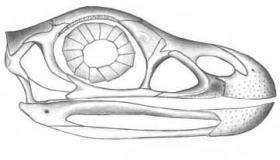New Fossil Find in New Mexico Named After Artist Georgia O'Keeffe

Two Columbia scientists have discovered the fossil of a toothless crocodile relative that looks like a six-foot-long, two-legged dinosaur, but is actually a distant cousin of today's alligators and crocodiles.
Adjunct professor of earth and environmental sciences Mark Norell and his graduate student Sterling Nesbitt, both of whom also work as paleontologists at the American Museum of Natural History, have named the fossil Effigia okeeffeae.
Effigia means "ghost," referring to the decades that the fossil remained hidden from science. The species name, okeeffeae, honors the artist Georgia O'Keeffe, who lived near the site in northern New Mexico where the fossil was found.
The discovery was announced last month in a technical paper in The Proceedings of the Royal Society and covered in the The New York Times. Click here to see.
Scientists say Effigia is a striking example of "convergence," when two lineages evolve the same body plan.
"It is astounding to see so many advanced dinosaur features in an animal so closely related to modern crocodiles, Norell said. Obviously, this group of crocodiles and dinosaurs must have had similar habitats and probably fed in the same way, accounting for the similarities of the limbs and skull."
Other examples of convergence include marsupial mammals related to kangaroos and opossums that evolved into creatures resembling lions and wolves.
The features of Effigia okeeffeae also were unexpected. "It has large eyes, a beak, it walked on two feet and had small hands," Nesbitt said.
Source: Columbia University

















